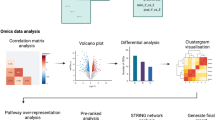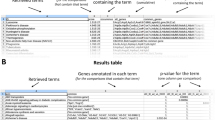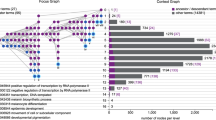Abstract
A major challenge in the analysis of gene expression microarray data is to extract meaningful biological knowledge out of the huge volume of raw data. Expander (EXPression ANalyzer and DisplayER) is an integrated software platform for the analysis of gene expression data, which is freely available for academic use. It is designed to support all the stages of microarray data analysis, from raw data normalization to inference of transcriptional regulatory networks. The microarray analysis described in this protocol starts with importing the data into Expander 5.0 and is followed by normalization and filtering. Then, clustering and network-based analyses are performed. The gene groups identified are tested for enrichment in function (based on Gene Ontology), co-regulation (using transcription factor and microRNA target predictions) or co-location. The results of each analysis step can be visualized in a number of ways. The complete protocol can be executed in ≈1 h.
This is a preview of subscription content, access via your institution
Access options
Subscribe to this journal
Receive 12 print issues and online access
$259.00 per year
only $21.58 per issue
Buy this article
- Purchase on Springer Link
- Instant access to full article PDF
Prices may be subject to local taxes which are calculated during checkout






Similar content being viewed by others
Accession codes
References
Sharan, R., Maron-Katz, A. & Shamir, R. CLICK and EXPANDER: a system for clustering and visualizing gene expression data. Bioinformatics 19, 1787–1799 (2003).
Sharan, R. & Shamir, R. CLICK: a clustering algorithm with applications to gene expression analysis. Proc. Int. Conf. Intell. Syst. Mol. Biol. 8, 307–316 (2000).
Elkon, R., Linhart, C., Sharan, R., Shamir, R. & Shiloh, Y. Genome-wide in silico identification of transcriptional regulators controlling the cell cycle in human cells. Genome Res. 13, 773–780 (2003).
Shamir, R. et al. EXPANDER—an integrative program suite for microarray data analysis. BMC Bioinformatics 6, 232 (2005).
Tanay, A., Sharan, R., Kupiec, M. & Shamir, R. Revealing modularity and organization in the yeast molecular network by integrated analysis of highly heterogeneous genomewide data. Proc. Natl. Acad. Sci. USA 101, 2981–2986 (2004).
Tanay, A., Sharan, R. & Shamir, R. Discovering statistically significant biclusters in gene expression data. Bioinformatics 18 (Suppl 1): S136–S144 (2002).
Elkon, R., Linhart, C., Halperin, Y., Shiloh, Y. & Shamir, R. Functional genomic delineation of TLR-induced transcriptional networks. BMC Genomics 8, 394 (2007).
Elkon, R. et al. SPIKE—a database, visualization and analysis tool of cellular signaling pathways. BMC Bioinformatics 9, 110 (2008).
Muller, F.J. et al. Regulatory networks define phenotypic classes of human stem cell lines. Nature 455, 401–405 (2008).
Ulitsky, I. & Shamir, R. Identification of functional modules using network topology and high-throughput data. BMC Syst. Biol. 1, 8 (2007).
Kuehn, H., Liberzon, A., Reich, M. & Mesirov, J.P. Using GenePattern for gene expression analysis. Curr. Protoc. Bioinformatics Chapter 7 Unit 7 12 (2008).
Li, C. & Wong, W.H. Model-based analysis of oligonucleotide arrays: expression index computation and outlier detection. Proc. Natl. Acad. Sci. USA 98, 31–36 (2001).
Saeed, A.I. et al. TM4: a free, open-source system for microarray data management and analysis. Biotechniques 34, 374–378 (2003).
Stavrum, A.K., Petersen, K., Jonassen, I. & Dysvik, B. Analysis of gene-expression data using J-Express. Curr. Protoc. Bioinformatics Chapter 7 Unit 7 3 (2008).
Rustici, G. et al. Data storage and analysis in ArrayExpress and Expression Profiler. Curr. Protoc. Bioinformatics. Chapter 7 Unit 7 13 (2008).
Tarraga, J. et al. GEPAS, a web-based tool for microarray data analysis and interpretation. Nucleic Acids Res. 36, W308–W314 (2008).
Sturn, A., Quackenbush, J. & Trajanoski, Z. Genesis: cluster analysis of microarray data. Bioinformatics 18, 207–208 (2002).
Cline, M.S. et al. Integration of biological networks and gene expression data using Cytoscape. Nat. Protoc. 2, 2366–2382 (2007).
Stern, S., Dror, T., Stolovicki, E., Brenner, N. & Braun, E. Genome-wide transcriptional plasticity underlies cellular adaptation to novel challenge. Mol. Syst. Biol. 3, 106 (2007).
Rosenzweig, D. et al. Retooling Leishmania metabolism: from sand fly gut to human macrophage. FASEB J. 22, 590–602 (2008).
Oron, E. et al. Genomic analysis of COP9 signalosome function in Drosophila melanogaster reveals a role in temporal regulation of gene expression. Mol. Syst. Biol. 3, 108 (2007).
Blum, R. et al. Gene expression signature of human cancer cell lines treated with the ras inhibitor salirasib (S-farnesylthiosalicylic acid). Cancer Res. 67, 3320–3328 (2007).
Elkon, R. et al. Dissection of a DNA-damage-induced transcriptional network using a combination of microarrays, RNA interference and computational promoter analysis. Genome Biol. 6, R43 (2005).
Blum, R. et al. E2F1 identified by promoter and biochemical analysis as a central target of glioblastoma cell-cycle arrest in response to Ras inhibition. Int. J. Cancer 119, 527–538 (2006).
Laurent, L.C. et al. Comprehensive microRNA profiling reveals a unique human embryonic stem cell signature dominated by a single seed sequence. Stem Cells 26, 1506–1516 (2008).
Rodriguez, A. et al. Requirement of bic/microRNA-155 for normal immune function. Science 316, 608–611 (2007).
Irizarry, R.A. et al. Summaries of Affymetrix GeneChip probe level data. Nucleic Acids Res. 31, e15 (2003).
Smedley, D. et al. BioMart—biological queries made easy. BMC Genomics 10, 22 (2009).
Schadt, E.E., Li, C., Ellis, B. & Wong, W.H. Feature extraction and normalization algorithms for high-density oligonucleotide gene expression array data. J. Cell. Biochem. Suppl. (Suppl 37): 120–125 (2001).
Bolstad, B.M., Irizarry, R.A., Astrand, M. & Speed, T.P. A comparison of normalization methods for high density oligonucleotide array data based on variance and bias. Bioinformatics 19, 185–193 (2003).
Eisen, M.B., Spellman, P.T., Brown, P.O. & Botstein, D. Cluster analysis and display of genome-wide expression patterns. Proc. Natl. Acad. Sci. USA 95, 14863–14868 (1998).
Raychaudhuri, S., Stuart, J.M. & Altman, R.B. Principal components analysis to summarize microarray experiments: application to sporulation time series. Pac. Symp. Biocomput. 455–466 (2000).
Tamayo, P. et al. Interpreting patterns of gene expression with self-organizing maps: methods and application to hematopoietic differentiation. Proc. Natl. Acad. Sci. USA 96, 2907–2912 (1999).
Tavazoie, S., Hughes, J.D., Campbell, M.J., Cho, R.J. & Church, G.M. Systematic determination of genetic network architecture. Nat. Genet. 22, 281–285 (1999).
Tanay, A., Steinfeld, I., Kupiec, M. & Shamir, R. Integrative analysis of genome-wide experiments in the context of a large high-throughput data compendium. Mol. Syst. Biol. 1, 2005.0002 (2005).
Hanisch, D., Zien, A., Zimmer, R. & Lengauer, T. Co-clustering of biological networks and gene expression data. Bioinformatics 18 (Suppl 1): S145–S154 (2002).
Ideker, T., Ozier, O., Schwikowski, B. & Siegel, A.F. Discovering regulatory and signalling circuits in molecular interaction networks. Bioinformatics 18 (Suppl 1): S233–S240 (2002).
Liu, M. et al. Network-based analysis of affected biological processes in type 2 diabetes models. PLoS Genet. 3, e96 (2007).
Luscombe, N.M. et al. Genomic analysis of regulatory network dynamics reveals large topological changes. Nature 431, 308–312 (2004).
Suzuki, H. et al. The transcriptional network that controls growth arrest and differentiation in a human myeloid leukemia cell line. Nat. Genet. 41, 553–562 (2009).
Farh, K.K. et al. The widespread impact of mammalian microRNAs on mRNA repression and evolution. Science 310, 1817–1821 (2005).
Lim, L.P. et al. Microarray analysis shows that some microRNAs downregulate large numbers of target mRNAs. Nature 433, 769–773 (2005).
Halperin, Y., Linhart, C., Ulitsky, I. & Shamir, R. Allegro: analyzing expression and sequence in concert to discover regulatory programs. Nucleic Acids Res. 37, 1566–1579 (2009).
Friedman, R.C., Farh, K.K., Burge, C.B. & Bartel, D.P. Most mammalian mRNAs are conserved targets of microRNAs. Genome Res. 19, 92–105 (2009).
Grimson, A. et al. MicroRNA targeting specificity in mammals: determinants beyond seed pairing. Mol. Cell 27, 91–105 (2007).
Ripley, B. The R project in statistical computing. MSOR Connections. The newsletter of the LTSN Maths, Stats & OR Network 1, 23–25 (2001).
Hermjakob, H. et al. IntAct: an open source molecular interaction database. Nucleic Acids Res. 32, D452–D455 (2004).
Troyanskaya, O. et al. Missing value estimation methods for DNA microarrays. Bioinformatics 17, 520–525 (2001).
Quackenbush, J. Computational analysis of microarray data. Nat. Rev. Genet. 2, 418–427 (2001).
Ashburner, M. et al. Gene Ontology: tool for the unification of biology. The Gene Ontology Consortium. Nat. Genet. 25, 25–29 (2000).
Wingender, E. et al. TRANSFAC: an integrated system for gene expression regulation. Nucleic Acids Res. 28, 316–319 (2000).
Warren, M.K. & Ralph, P. Macrophage growth factor CSF-1 stimulates human monocyte production of interferon, tumor necrosis factor, and colony stimulating activity. J. Immunol. 137, 2281–2285 (1986).
Um, H.D., Orenstein, J.M. & Wahl, S.M. Fas mediates apoptosis in human monocytes by a reactive oxygen intermediate dependent pathway. J. Immunol. 156, 3469–3477 (1996).
Tusher, V.G., Tibshirani, R. & Chu, G. Significance analysis of microarrays applied to the ionizing radiation response. Proc. Natl. Acad. Sci. USA 98, 5116–5121 (2001).
Benjamini, Y. & Hochberg, Y. Controlling the false discovery rate: a practical and powerful approach to multiple testing. Journal of the Royal Statistical Society. Series B (Methodological) 289–300 (1995).
Subramanian, A. et al. Gene set enrichment analysis: a knowledge-based approach for interpreting genome-wide expression profiles. Proc. Natl. Acad. Sci. USA 102, 15545–15550 (2005).
Gaidatzis, D., van Nimwegen, E., Hausser, J. & Zavolan, M. Inference of miRNA targets using evolutionary conservation and pathway analysis. BMC Bioinformatics 8, 69 (2007).
Stark, A., Brennecke, J., Bushati, N., Russell, R.B. & Cohen, S.M. Animal microRNAs confer robustness to gene expression and have a significant impact on 3′UTR evolution. Cell 123, 1133–1146 (2005).
Rajewsky, N. microRNA target predictions in animals. Nat. Genet. 38 (Suppl): S8–S13 (2006).
Baek, D. et al. The impact of microRNAs on protein output. Nature 455, 64–71 (2008).
Nielsen, C.B. et al. Determinants of targeting by endogenous and exogenous microRNAs and siRNAs. RNA 13, 1894–1910 (2007).
Sandberg, R., Neilson, J.R., Sarma, A., Sharp, P.A. & Burge, C.B. Proliferating cells express mRNAs with shortened 3′ untranslated regions and fewer microRNA target sites. Science 320, 1643–1647 (2008).
Kanehisa, M. & Goto, S. KEGG: Kyoto encyclopedia of genes and genomes. Nucleic Acids Res. 28, 27–30 (2000).
Matthews, L. et al. Reactome knowledgebase of human biological pathways and processes. Nucleic Acids Res. 37, D619–D622 (2009).
Acknowledgements
We thank Israel Steinfeld for his role in the early development of Expander, Metsada Pasmanik-Chor for useful discussions and Akshay Krishnamurthy for commenting on an early version of the protocol. Igor Ulitsky was partially supported by the Edmond J Safra Bioinformatics Program at Tel Aviv University and by the Legacy Heritage Fund. Yosef Shiloh is a Research Professor of the Israel Cancer Research Fund. This study was supported in part by the Israel Science Foundation (Grant No. 802/08) and by the European Community's Seventh Framework Programme (Grants HEALTH-F4-2007-200767 for the APO-SYS project and HEALTH-F4-2009-223575 for the TRIREME project).
Author information
Authors and Affiliations
Contributions
R.S. conceived and led the project; A.M.-K., S.S. and D.S. developed Expander using software code contributed by R.S., A.T., C.L., R.E. and I.U.; I.U. and R.S. wrote the paper. All the authors contributed to the design of Expander, and all have read and approved the paper.
Corresponding author
Ethics declarations
Competing interests
Expander is available for commercial licensing through Tel Aviv University's technology transfer company.
Supplementary information
Supplementary Data 1
BMM.txt contains a microarray dataset constructed by the Innate Immunity Systems Biology project (http://www.innateimmunity-systemsbiology.org/), in which expression profiles were recorded in murine bone marrow-derived macrophage cells (BMMs) at several time points after exposure to six agents. (TXT 15753 kb)
Supplementary Data 2
MG430_2.0_Probe2EntrezGene.txt contains a mapping of Affymetrix Murine Genome (MG) U430 2.0 probes to Entrez Gene identifiers, taken from BioMart24. (TXT 573 kb)
Supplementary Data 3
Mir155.txt contains a microarray dataset due to Rodriguez et al.22, in which five repeats of Th1 cells deficient for mir-155 are compared with five controls (obtained from the ArrayExpress database, accession number E-TABM-232). (TXT 3337 kb)
Supplementary Data 4
mouse.IntAct.sif a mouse PPI network taken from the IntAct database43, in SIF format. (TXT 35 kb)
Rights and permissions
About this article
Cite this article
Ulitsky, I., Maron-Katz, A., Shavit, S. et al. Expander: from expression microarrays to networks and functions. Nat Protoc 5, 303–322 (2010). https://doi.org/10.1038/nprot.2009.230
Published:
Issue Date:
DOI: https://doi.org/10.1038/nprot.2009.230
This article is cited by
-
Genome-wide analysis of MYB transcription factors of Vaccinium corymbosum and their positive responses to drought stress
BMC Genomics (2021)
-
Classification of node-positive melanomas into prognostic subgroups using keratin, immune, and melanogenesis expression patterns
Oncogene (2021)
-
Guard cells control hypocotyl elongation through HXK1, HY5, and PIF4
Communications Biology (2021)
-
GATA2 regulates mast cell identity and responsiveness to antigenic stimulation by promoting chromatin remodeling at super-enhancers
Nature Communications (2021)
-
Transcriptomic analysis of cork during seasonal growth highlights regulatory and developmental processes from phellogen to phellem formation
Scientific Reports (2021)
Comments
By submitting a comment you agree to abide by our Terms and Community Guidelines. If you find something abusive or that does not comply with our terms or guidelines please flag it as inappropriate.



